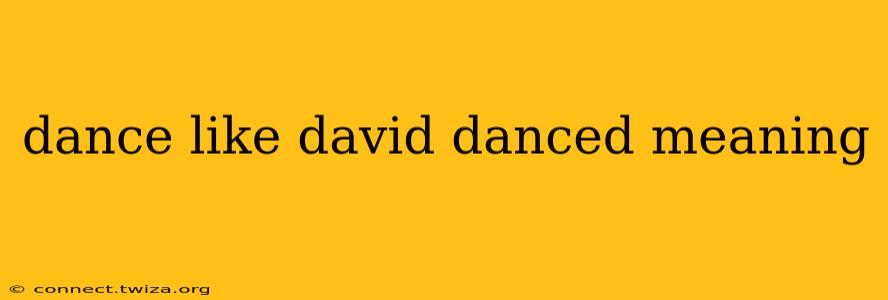The phrase "dance like David danced" is a powerful call to action, urging unrestrained joy, passionate worship, and uninhibited self-expression through movement. It transcends mere physical activity; it speaks to a deeper spiritual and emotional release. But what exactly does it mean to dance like David danced? Let's explore the biblical context and its broader implications.
What Did David Dance Like?
The primary source for understanding this iconic image comes from 2 Samuel 6, which describes David's jubilant celebration upon bringing the Ark of the Covenant to Jerusalem. The biblical account depicts David leaping, whirling, and dancing with unrestrained energy before the Lord. He wasn't performing a structured, formal dance; rather, he was expressing profound joy and devotion through spontaneous, ecstatic movement. His actions were so exuberant that they even drew criticism from his wife, Michal.
This wasn't a typical dance; it was an act of worship, a passionate outpouring of his heart before God. It highlights the uninhibited joy and unreserved devotion that characterized David's relationship with the Almighty.
Why Does David's Dance Resonate Today?
David's dance resonates even today because it speaks to a fundamental human need: the desire to express our deepest emotions through movement. In a world often characterized by restraint and formality, his example provides a powerful counterpoint. It encourages us to:
-
Embrace Authentic Self-Expression: David didn't worry about looking foolish or conforming to societal expectations. He danced freely, expressing his genuine joy and devotion without reservation. This inspires us to shed self-consciousness and embrace our true selves.
-
Find Joy in Worship: David's dance was an act of worship, a physical manifestation of his spiritual devotion. It reminds us that worship can be joyful, energetic, and fully expressive.
-
Let Go of Inhibitions: His dance was uninhibited and spontaneous. This encourages us to let go of our inhibitions and embrace the freedom of unconstrained movement.
How Can I Dance Like David Danced?
Dancing "like David danced" isn't about mimicking a specific set of steps; it's about embracing the spirit of his dance:
-
Connect with Your Inner Spirit: Before you even begin to move, connect with your inner self, whatever that means to you—through prayer, meditation, or simply taking a moment for introspection.
-
Find Your Own Movement: Don't worry about perfection or technique. Let your body move naturally, expressing the emotions you feel.
-
Embrace Spontaneity: Allow yourself to move freely and spontaneously, without pre-planned choreography.
-
Let Go of Self-Consciousness: Dance as if no one is watching. Focus on the expression, not the performance.
-
Find Your Own Expression of Worship: It's not about religious dogma; it's about connecting with something larger than yourself through movement.
Frequently Asked Questions
What type of dance did David do in the Bible?
The Bible doesn't specify a particular dance style. David's dance was spontaneous and uninhibited, an expression of his deep joy and devotion to God. It wasn't a formal, choreographed dance.
What does David's dance teach us about worship?
David's dance demonstrates that worship can be joyful, passionate, and physically expressive. It shows that genuine worship isn't confined to formal rituals; it can be an uninhibited outpouring of the heart before God.
Is there a specific way to "dance like David danced"?
There's no prescribed way. The key is to let go of inhibitions, express your emotions freely, and connect with your inner self through movement. It's about the spirit of the dance, not a specific technique.
What is the significance of Michal's reaction to David's dance?
Michal's criticism highlights the cultural context of the time and the contrasting views on appropriate expressions of religious devotion. Her reaction serves as a reminder that authentic self-expression can sometimes clash with societal norms.
In conclusion, "dance like David danced" is a powerful metaphor urging us to embrace uninhibited joy, passionate worship, and authentic self-expression. It's a call to break free from constraints, connect with our inner selves, and find freedom in movement. It's about letting go and letting our spirits soar.
